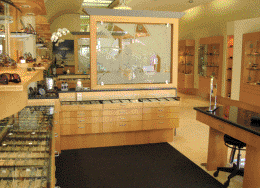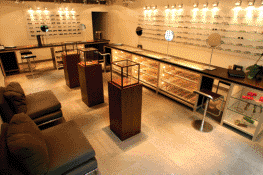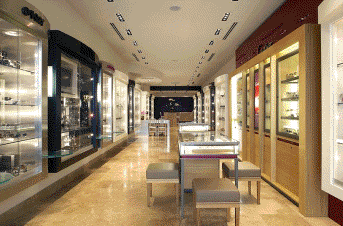
Top Tier Changes
A rush of consolidation and buyouts in the high-end optical market has opened the door for expansion of this highly profitable sector. A look at where we�re headed�and how the ECP fits into this new landscape
The luxury goods market is on the move�both inside and outside the optical industry. An estimated $1 trillion was spent in 2005 on luxury goods and services, according to the Unity Marketing Luxury Report, 2006.
High-end sales influence optical inventory decisions in an effort to get a piece of the luxury pie. A recent Eyecare Business Professional Perspectives survey revealed that high-end frames now account for close to 45 percent of ECPs� inventories. As the high-end continues on its growth trajectory, this retail segment is attracting a new audience of consumers and retailers.



The high-end retail scene is changing as consolidation becomes a part of the picture. Some retailers, like Robert Marc (center), remain independent
Consolidation: the High-End comes Together
This tempting market has caught the eye of big business, and last year marked the beginning of the high-end�s consolidation in optical retail. LO Holdings, a consortium group, purchased several small luxury chains in 2006, including Davante, Morgenthal-Frederics, and Optica. �This is such a natural course,� says Pierre Keyser, CEO of LO Holdings. �This has been going on in the lower and middle parts of the market for a while now.�
Oakley has also made its presence known in the high-end
sector by purchasing the Optical Shop of Aspen chain in 2006 as well as Oliver Peoples, the style-driven, high-end frame company. �High-end optical serves a very distinct and exclusive market, and we feel there is excellent growth opportunity in the platform,� says Lance Allegra, Oakley�s director of investor relations.
Along with purchasing existing groups, both LO Holdings and Oakley have a focus on expanding their existing store formats.
�We will definitely open new stores,� says Keyser. �We have quite a few new locations in the works. The new stores will be opened up under one of the existing names or store concepts.�
Oakley, which also owns 121 Sunglass Icon stores and 80 Oakley stores (where only Oakley-branded products are sold), has similar plans to expand. �When we acquired The Optical Shop of Aspen in April, it had 14 locations. At the end of 2006, we were at 20 locations. So we definitely feel that this platform has headroom and the ability to open new locations in areas untouched by this concept,� Allegra notes.
Even smaller chains have an eye on expansion. �Without question, we will continue to expand,� says Brad Childs, vice president of the five-store Eyetique chain in Pittsburgh. �We plan to continue at a pace of three stores in a two-year period.�
With consolidation and chain expansion growing in the high-end of the industry, some retailers wonder what the future holds.


The high-end market is diversifying Optical Shop of Aspen, above, is now part of Oakley, while Robert Marc�s six New York locations remain independent
Q&A with Oakley
Insights from Lance Allegra, director of investor relations.
EB: When and why did Oakley purchase Oliver Peoples and OSA?
Lance Allegra: We bought Oliver Peoples in February 2006 and The Optical Shop of Aspen in April 2006. Optics is Oakley�s key strength and definitive brand foundation. We have a 30-year action sports heritage. So when we took a look at how we would be able to grow the brand into areas that we were not in at the time, it made sense to partner with a company that has been doing it well, is unique and, most importantly, has the same core cultural and visionary values we do. Oliver Peoples was that company. Adding Oliver Peoples, Mosley Tribes, and Paul Smith to the Oakley, Inc., portfolio, which also includes Dragon and Fox, allows the overall company to fulfill different needs of discriminating consumers. The Optical Shop of Aspen acquisition figured into our retail equation in a similar fashion. OSA filled a niche we weren�t playing in�ultra-high end, luxury optical�an arena known for design, exclusivity and customer service.
EB: Why was the time right in the industry for this to happen?
Allegra: While I can�t speak on the industry�s behalf, it was the right timing for Oakley because we are strategically positioning ourselves to build solid business platforms capable of driving long-term, profitable growth. Ultimately, we were able to partner with extremely unique and complementary brands which strengthened Oakley�s portfolio effect, creating more opportunities for the individual brands based on our resources and creating more opportunity for us based on their consumer base.
EB: Does Oakley plan further expansion of the OSA retail concept?
Allegra: High-end optical serves a very distinct and exclusive market and we feel there is excellent growth opportunity in the platform.
The State of Things to Come
Opinions vary widely on the ramifications of the industry trend. On the �con� side, the power and influence of the consolidated groups have some retailers concerned that the market will become too crowded, resulting in closures.
�By next year, we will have 30 percent fewer players at the top in retail and the vendors will slowly follow,� predicts says Craig Chasnov, owner of Eyetopian, a chain of three luxury shops in Bonita Springs, Ft. Myers, and Naples, Fla. �All of a sudden we will have a hundred new high-end stores�the market doesn�t need anything else,� he adds.
On the flip side, there are those who think the change will not be for the worse, and it may be even be better for the market in the long run.
�There is so much talk about this, but in fact what we�re dealing with is a very small piece of the optical puzzle,� says Robert Marc, owner of the New York-based, six-location Robert Marc Opticians. �This is not changing the optical landscape.�
�They are not changing their pricing or distribution,� says Jack Schaeffer, owner of the 15-location, Birmingham-based Schaeffer Eye Center. �They will just have a little more money behind them and a more corporate look. Overall, we�ll have a lot more money in the industry and it�s good to get an infusion of money.�

Davante is now a part of LO Holdings, one of the leaders in the consolidation wave
Q&A with LO Holdings
A look inside with CEO Pierre Keyser.
EB: When did you form the company?
Pierre Keyser: This is something I�ve had in mind for a long time. I had it churning around since 1999. For one reason or another, I didn�t do it in �99 but wish I had because the valuation has changed quite a bit since then. We decided to pull the trigger about 18 months ago and finalized everything in May of last year.
EB: Did you expect Oakley to get into the market too?
Keyser: Oakley jumped into the game and bought OSA and that was a target of ours. We believe they are doing something different, however. We are more in the luxury field and they are a little more funky/trendy.
We are not in the same retail markets except for a few like Aspen. Their purpose is to integrate the Oliver Peoples and Oakley brands, so their strategy
is more vertical. For us, it�s a different strategy and the targets are more luxury brand players.
EB: What is the most important aspect of a store purchase?
Keyser: The most important part of the acquisition is the human capital aspect. We look at who is working there before we buy it. Our stores have been doing phenomenally well and retention has been great. The employees like it because they have more opportunity for growth.
EB: How will buying be handled for the company�s stores?
Keyser: All purchasing will be done from one central location here in Las Vegas. We just moved from a 4,000-square-feet office to 29,000-square-foot location.
Competing Ideas
Where will the high-end industry be in another year or two? Whether you are concerned about the stability of your market share or not, the fact is that your business should be at the top of its game. �Either I�m going to get bought or there will be more people who come into my neighborhood and compete,� says Chasnov.
�Retailers need to pay attention to the extent that they should already have been paying to merchandising,� says Marc. �What merchandise do you have? What is your product mix? How is it being presented? And, in thinking about the brands you are carrying, what is your exclusivity?�
Others are focusing on different categories to keep a competitive edge. Chasnov is now running programs with Ophthonix and wavefront technology. �I just ordered two more machines and am doing testing with pilots,� he says. �My new ad says, �The new standard is 20/15.� This opens up a new market.�
If competition does come your way, experts advise ECPs to �Do what they won�t do.� Childs says, �You have to stay focused. You have to adapt to your environment, overcome it, stick to your plan, and move ahead.�
He says if you offer customers a unique, high-end experience, they will always come back. �It doesn�t matter what the name is on the door, from Wal-Mart to LensCrafters to the high-end independent. If they have a great experience, they will come back.� EB



